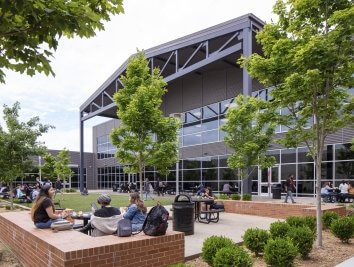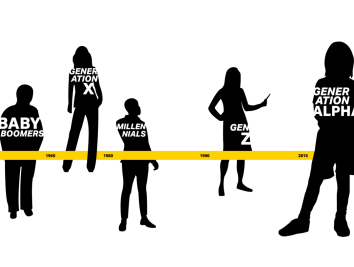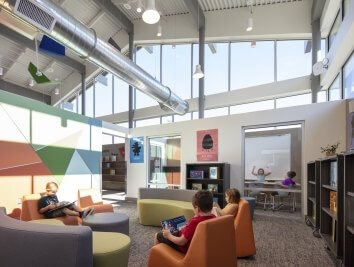Designing for Mental Health: Educational Facilities
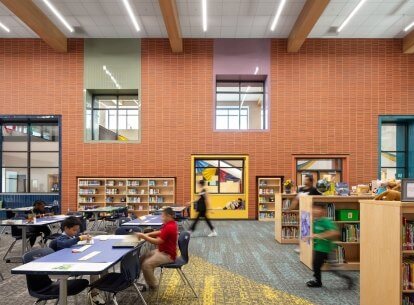
Children spend most of their waking hours at school, in an environment that is largely out of their control. To be truly user-focused, school design should consider the whole child: not just their physical safety and their educational progress, but also their emotional and mental wellbeing. Chloe Hosid, an Education Design Research Specialist, reviews strategies designers can take to support mental health through school design.
The Kids Aren’t Alright
According to the CDC, rates of depression and anxiety in children between the ages of 6 and 17 have increased over time. A 2023 study focusing on loneliness and the mental well-being of children during the COVID-19 pandemic showed depression and anxiety symptoms doubled when comparing pre-pandemic and post-pandemic numbers. The loneliness epidemic has become so severe that in 2023, U.S. Surgeon General Vivek Murthy authored an advisory on the topic, noting that “loneliness and social isolation among children and adolescents increase the risk of depression and anxiety.” Correspondingly, social connection is a protective factor against developing depression, even for those who are predisposed to depression. Considering these factors, designing schools to support children’s mental health is an increasingly important enterprise.
Making "Place" Palliative
At its best, we want a place to convey belonging, value, opportunity, and connection to its inhabitants. A good school can – and should – do that by activating place attachment. The benefits of place attachment include connection to memories, belonging, comfort and security, relaxation, and positive emotions like happiness and pride.
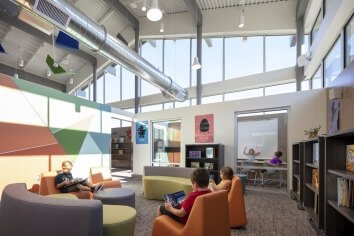
For younger children, researchers found that this attachment is best accomplished through an environment that facilitates exploration, sensory engagement, and play. Vibrant, playful spaces that facilitate open-ended use are better for children, who show a heightened attentiveness to place and tend to focus on what they can do in an environment.
The same study found that for older students, place attachment is better achieved by focusing on cognitive engagement rather than sensory engagement, allowing adolescents to find deeper meaning in their environment. For these students, the emphasis should be on spaces that promote connection with mentors and peers; opportunities for learning to support their autonomy, passions, and identity; and restorative environments that promote well-being.
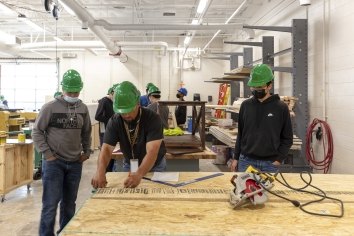
Since children spend most of their time outside the home at school, it can become a second home. Research shows that children have increasingly less independent access to the world, making safe places – like schools – important opportunities for children to develop place attachments outside of their homes. Therefore, schools have a vital opportunity to foster social connection and belonging for students.
Case Study
Place Attachment

To foster place attachment at Arlington ISD’s Thornton Elementary School, designers focused on enhancing memory and belonging:
- Inspired by Folklorico dance and the community’s predominately Hispanic heritage, the design imparts a sense of belonging and identity for the students and their families through the use of colors, patterns, and materials as a celebration of community culture.
- Welcoming community spaces have been integrated into the design to support parent and community involvement and the high percentage of students who walk to school with their parents.
Reducing Stressors
Providing a learning environment that supports mental health should be designed to mitigate common stressors in the school environment. Stressors can include too much sensory input, poor environmental quality, developmental misalignment, limited personalization, lack of opportunity for psychological restoration, and concerns about safety and cleanliness.
A 2015 study indicated that stimulation and individualization each comprise about a quarter of the environment-related impact on student performance, while naturalness factors like air quality, temperature, and light accounted for the other half. When designing schools, designers should keep the following considerations in mind to reduce stressors and enhance the learning environment:
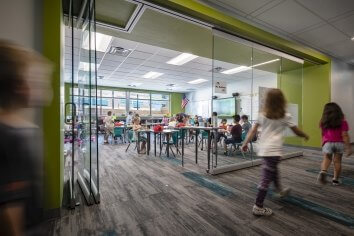
Attention is a limited cognitive resource that is necessary for filtering information (including sensory input) and focusing on relevant information. The visual, tactile, and auditory information students are exposed to in the classroom can influence their ability to focus, causing frustration and behavioral challenges – particularly for students with sensory processing differences. Classrooms should balance visual complexity and color to strike the balance between being warm and engaging without becoming chaotic or distracting. Designers should also account for acoustic considerations, including spatial adjacencies, sound attenuation, and noise levels from HVAC equipment. Tactile design elements can be integrated to provide engagement through textures and movement.
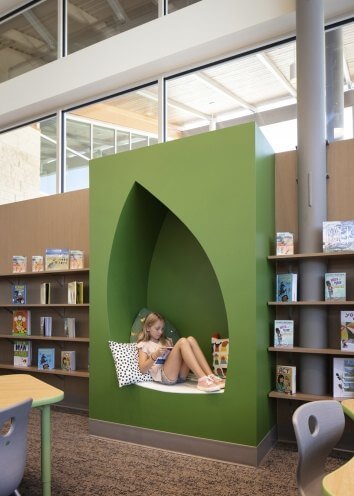
Limited choice in the learning environment hinders a student (or teacher’s!) agency to support their own individual needs, ability to focus, and capacity to perform at their best. Designers should provide a variety of seating options, adaptable furniture, tunable workstations, opportunities for movement, and consider differentiated spaces with a range of affordances and sensory qualities to accommodate individual needs. Including spatial zones and design features ranging from lively, collaborative, and interactive shared spaces, to quiet, individual, and restorative nooks can provide students with the environmental resources they need to support their own health, well-being, and learning.
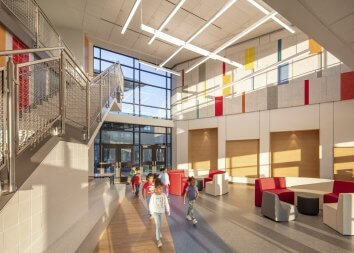
Naturalness factors, such as air quality, thermal comfort, natural light, and access to nature have a direct impact on learning and well-being. Lighting and access to natural light can have implications for students’ health, well-being, and learning outcomes, with daytime blue light and natural light providing measurable benefits for alertness and academic performance. In addition to maximizing windows for natural light and views to nature, designers can incorporate biophilic elements like natural wood or stone, greenery, and natural forms.
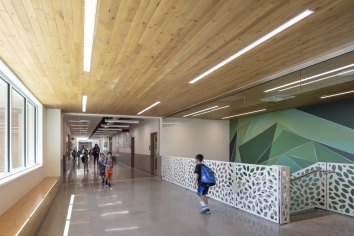
To reduce stressors at Dripping Springs ISD’s Cypress Springs Elementary School, designers focused on relaxation and a connection to nature:
1. The design reflects the Texas Hill Country aesthetic, nestling the school into the landscape and integrating nature into the learning environment.
2. The integration of natural light, natural materials, biophilic colors and patterns, and views and access to the beautiful landscape beyond the school provides a feeling of relaxation and restoration. This feeling is a signal that the environment is supporting psychophysiological needs for students and teachers.
Express Yourself
For a lot of students, quietly sitting in a classroom for hours on end can be like putting a square peg into a round hole, a mismatch that can be deleterious to their self-esteem and mental health. As school design (and the field of education) evolves, we are constantly looking for opportunities to nurture student potential in its many forms, celebrating multiple forms of intelligence to enhance their school experience and improve their mental health.
A growing body of research shows creative expression can positively impact mental health. Engaging in creative activities can help students feel empowered, encourage problem solving, and support social activity, all of which enhance their mental health. Integrating creativity—and other opportunities for self-expression—into schools gives students an opportunity to display their hard work and natural talents.
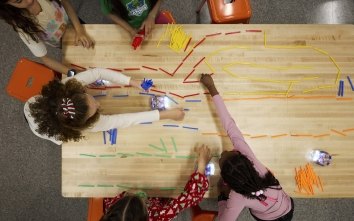
These opportunities for creativity and self-expression can be rooted in music, fine arts, and performing arts education, but this focus can also be expanded to integrate STEM, career technology, community engagement, and entrepreneurship to allow students’ passion and ingenuity to make an impact beyond the classroom.
Designers can support students by providing constructive opportunities for self-expression within the school building. Creative activities can be supported by spaces designated for performances and presentations, display of student work, hands-on projects, and even “incubator” spaces where students can collaborate, problem-solve, and develop innovative ideas. These features don’t just enhance learning, they also make students feel valued and show that what they are learning in school matters in the real world.
Case Study
AmTech Career Academy
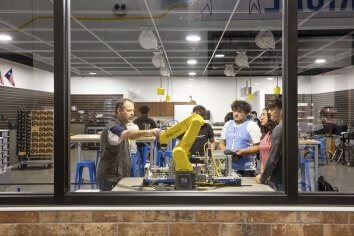
At the AmTech Career Academy in Amarillo ISD, Corgan focused on providing students with activity support and opportunities for personal growth:
- With learning on display throughout the facility, a wide variety of skilled trades – ranging from creative to technical – are showcased, providing pathways to career opportunities in the local region. Through this visibility, students are encouraged to explore new possibilities, make connections, learn from their peers, and showcase their talents.
- The facility provides high-fidelity learning environments that mirror the real world and encourage students to see themselves as capable young professionals, providing the tools and experiences needed to kickstart a successful career.
- Unifying AmTech’s 36 programs under one roof allows students to forge their own path- AmTech students have even started their own businesses while in high school.
AmTech Career Academy, Amarillo ISD
What’s Next: Supporting Teachers with Disabilities Through Inclusive Design
Educators are a critical part of supporting mental health for students, but their own needs are often overlooked. Expanding a focus on supporting the needs of teachers and filling a gap in existing literature, Corgan is exploring the unique perspectives of teachers with disabilities through a research study supported by the American Society of Interior Designers Foundation. Gathering insight from real teachers with visible, invisible, temporary, and chronic disabilities and conditions – including learning differences, chronic illness, physical disabilities, and visual impairments – Corgan aims to identify opportunities for design to better support these valued educators in their working environment.





